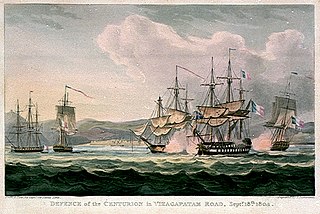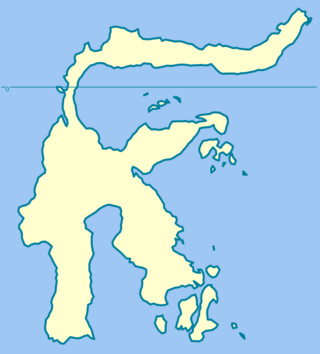HMS Leda, launched in 1800, was the lead ship of a successful class of forty-seven British Royal Navy 38-gun sailing frigates. Leda's design was based on the French Hébé, which the British had captured in 1782. Leda was wrecked at the mouth of Milford Haven in 1808, Captain Honeyman was exonerated of all blame, as it was a pilot error.

Franchise was launched in 1798 as a 40-gun Coquille-class frigate of the French Navy. The British captured her in 1803 and took her into the Royal Navy under her existing name. In the war on commerce during the Napoleonic Wars she was more protector than prize-taker, capturing many small privateers but few commercial prizes. She was also at the battle of Copenhagen. She was broken up in 1815.

HMS Hindostan was a 50-gun two-decker fourth rate of the Royal Navy. She was originally a teak-built East Indiaman named Admiral Rainier launched at Calcutta in 1799 that the Royal Navy brought into service in May 1804. Before the Royal Navy purchased her, Admiral Rainier made two trips to England for the British East India Company (EIC), as an "extra ship", i.e., under charter. Perhaps her best known voyage was her trip to Australia in 1809 when she and Dromedary brought Governor Lachlan Macquarie to replace Governor William Bligh after the Rum Rebellion. In later years she became a store ship, and in 1819 was renamed Dolphin. She was hulked in 1824 to serve as a prison ship, and renamed Justitia in 1831. She was finally sold in 1855.

Jean-Jacques Rousseau was a Téméraire class 74-gun ship of the line of the French Navy, active during the French Directory, French Consulate and First French Empire. Renamed Marengo in 1802, she took part in Linois' operations in the Indian Ocean before her capture by the Royal Navy.

The Atalante was a 40-gun Virginie-class frigate of the French Navy, launched in 1802.

The action of 18 October 1806 was a minor naval engagement during the Napoleonic Wars, fought between the British Royal Navy frigate HMS Caroline and a Dutch squadron at the entrance to Batavia harbour on Java in the Dutch East Indies. During the battle the Dutch frigate Maria Riggersbergen was left unsupported by the remainder of the squadron and, isolated, was forced to surrender. Captain Peter Rainier, the British commander, was subsequently free to remove his prize from within sight of the Dutch port when the remainder of the Dutch squadron refused to engage Caroline and their crews deliberately grounded the ships to avoid capture. He also returned many prisoners taken previously in a captured brig.

The action of 26 July 1806 was a minor naval engagement of the Napoleonic Wars fought off the southern coast of the island of Celebes in the Dutch East Indies. During the battle, a small British squadron attacked and defeated a Dutch force defending a valuable convoy, which was also captured. The British force—consisting of the frigate HMS Greyhound and brig-sloop HMS Harrier under the command of Captain Edward Elphinstone—was initially wary of the Dutch, mistaking the Dutch East Indiaman merchant ship Victoria for a ship of the line. Closer observation revealed the identity of the Dutch vessels the following day and Elphinstone led his frigate against the leading Dutch warship Pallas while Harrier engaged the merchant vessels and forced them to surrender. Only the corvette William escaped, taking no part in the engagement.

The Java campaign of 1806–1807 was a minor campaign during the Napoleonic Wars by British Royal Navy forces against a naval squadron of the Kingdom of Holland, a client state of the French Empire, based on the island of Java in the Dutch East Indies. Seeking to eliminate any threat to valuable British merchant convoys passing through the Malacca Straits, Rear-Admiral Sir Edward Pellew determined in early 1806 that the Dutch naval forces based at Java, which included several ships of the line and three frigates, had to be defeated to ensure British dominance in the region. Lacking the forces to effect an invasion of the Dutch colony, Pellew instead sought to isolate and blockade the Dutch squadron based at Batavia in preparation for raids specifically targeting the Dutch ships with his main force.

The Raid on Batavia of 27 November 1806 was a successful attempt by a large British naval force to destroy the Dutch squadron based on Java in the Dutch East Indies that posed a threat to British shipping in the Straits of Malacca. The British admiral in command of the eastern Indian Ocean, Rear-Admiral Sir Edward Pellew, led a force of four ships of the line, two frigates and brig to the capital of Java at Batavia, in search of the squadron, which was reported to consist of a number of Dutch ships of the line and several smaller vessels. However the largest Dutch ships had already sailed eastwards towards Griessie over a month earlier, and Pellew only discovered the frigate Phoenix and a number of smaller warships in the bay, all of which were driven ashore by their crews rather than engage Pellew's force. The wrecks were subsequently burnt and Pellew, unaware of the whereabouts of the main Dutch squadron, returned to his base at Madras for the winter.

HMS Scorpion was a Royal Navy Cruizer-class brig-sloop built by John King at Dover and launched in 1803. She was the first of the class to be built since the launching of Cruizer in 1797. Scorpion had a long and active career during the Napoleonic Wars, earning her crews three clasps to the Naval General Service Medal when the Admiralty authorized it in 1847, two for single-ship actions. She also took a number of prizes. Scorpion was sold in 1819.
Bellona was a three-decker merchantman launched in 1782 at Limehouse by Woolcombe for Boyd & Co. She then traded for a decade before, in 1792, commencing a series of four voyages for the British East India Company as an "extra ship", that is, on a charter contract. During the first of these voyages she transported convicts from Britain to New South Wales. French privateers captured her and the British Royal Navy recaptured her, the Royal Navy seized her once, and then finally a French privateer captured her in February 1810 and scuttled her.
HMS Amboyna was the Dutch brig Harlingen, which the British captured in the East Indies in 1796. They renamed her Amboyna after their recent capture of Ambon Island. She then served briefly in the Royal Navy before she was broken up in 1802.
Atlas was built in Souths Shields by Temple and launched in 1801 for Temple. She made two voyages transporting convicts from Ireland or England to Port Jackson. On the first voyage she carried cargo for the British East India Company (EIC). On the second she sailed to Bengal after delivering her convicts to New South Wales and was wrecked off India in 1820 while on her way back to Britain.
Indefatigable was a square-rigged, three-decked, three-masted merchant ship launched in 1799 at Whitby for James Atty & Co. for the West Indies trade. In 1804 she served as an armed defense ship and recaptured a merchantman that a privateer had captured. She was a transport in the 1805–1806 British invasion of the Dutch Cape colony. She twice transported convicts to Australia; on the first trip she was chartered to the British East India Company (EIC). She burned to the waterline in 1815.
Admiral Gardner was launched in 1797 as an East Indiaman for the British East India Company (EIC). She made five voyages for the EIC, during the fourth of which she participated in an inconclusive single-ship action with a French privateer. Admiral Gardner was wrecked in January 1809. The wreck is a Protected Wreck managed by Historic England. She was named after Admiral Alan Gardner.
Union was launched at Calcutta in 1801. She sailed to England and then made five voyages as an East Indiaman for the British East India Company (EIC), between 1805 and 1814. She was wrecked in late 1815 or early 1816.
Policy was launched at Dartmouth in 1801. She was a whaler that made seven whaling voyages between 1803 and 1823. On her second whaling voyage, in 1804, she was able to capture two Dutch vessels. On her fourth voyage the United States Navy captured her, but the British Royal Navy recaptured her. She was lost at Tahiti in 1824 on her eighth whaling voyage.
Havik was built in Batavia in 1808 or 1809. The Dutch government purchased her and had her fitted out in 1809; she then sailed for North America. The British Royal Navy captured her in 1810. She then sailed to Britain where new owners named her Peter Proctor, after the British officer who captured her. She then traded widely and was last listed in 1845. She brought the first group of coolies from India to Australia in 1837.
Forbes was launched at Calcutta in 1805. She was wrecked in the Billeton Straits in the southern part of the Karimata Strait on 11 September 1806.

Captain Peter Rainier was a Royal Navy officer of the eighteenth and nineteenth centuries. Due to the patronage of his uncle, Vice-Admiral Peter Rainier, he was promoted quickly through the ranks so that by the age of twenty he was already a captain. He was given command of the 36-gun frigate HMS Caroline and on 18 October 1806 he fought a successful action in her against the Dutch 36-gun frigate Maria Reijersbergen at Batavia. He captured the treasure ship St Raphael in January 1807 off the Philippines, which had on board £500,000 worth of bullion coin. He left Caroline later in the year and received his next command, the 38-gun frigate HMS Niger, in June 1813. In Niger he participated in the capture of the French 44-gun frigate Ceres off the Cape Verde Islands in January 1814. He left Niger at the end of the Napoleonic Wars and did not receive another command until 1831 when he was given the 120-gun ship of the line HMS Britannia, in which he served in the Mediterranean Fleet until 1835. He died on 13 April of the following year in Southampton after a short illness.








